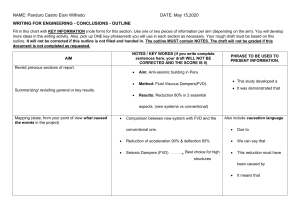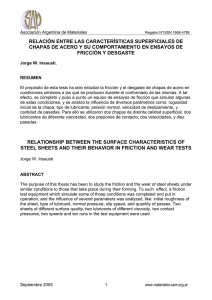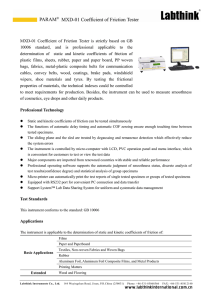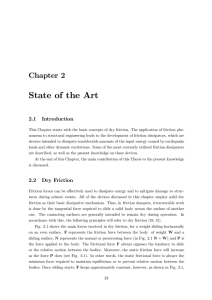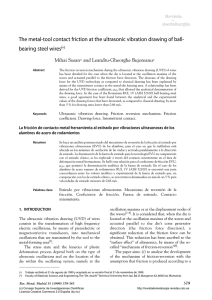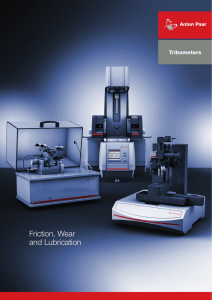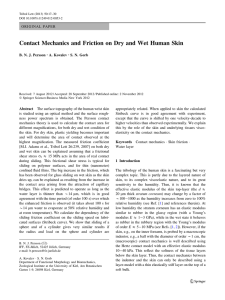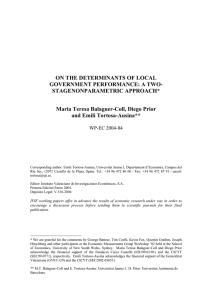Conclusions and Final Remarks
Anuncio
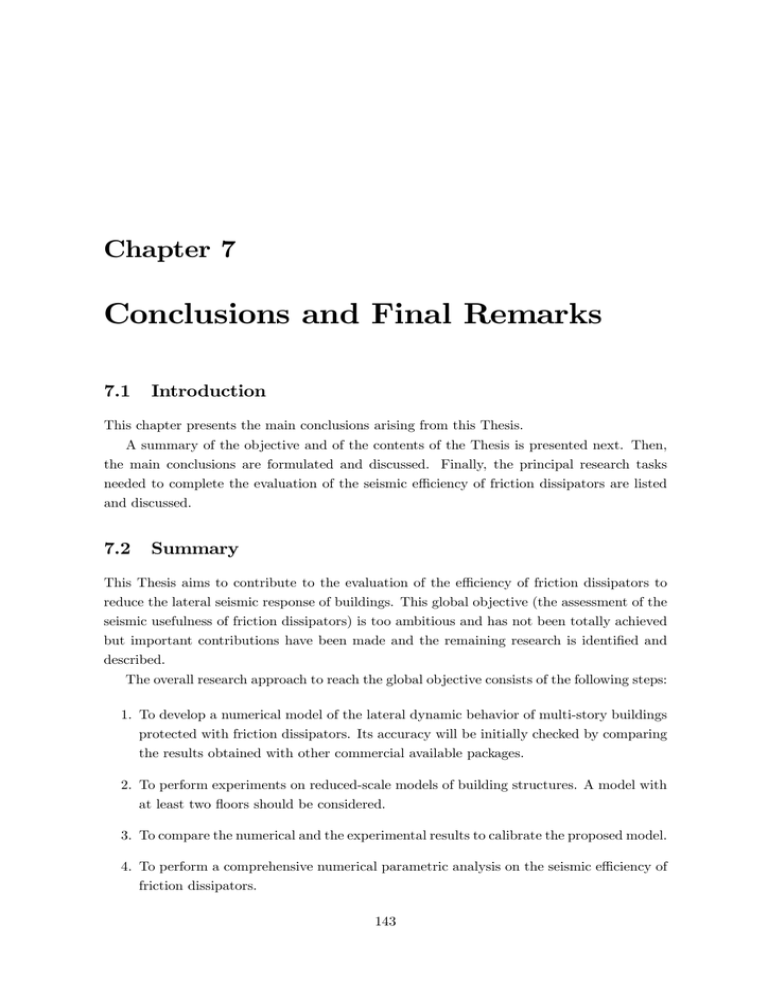
Chapter 7 Conclusions and Final Remarks 7.1 Introduction This chapter presents the main conclusions arising from this Thesis. A summary of the objective and of the contents of the Thesis is presented next. Then, the main conclusions are formulated and discussed. Finally, the principal research tasks needed to complete the evaluation of the seismic efficiency of friction dissipators are listed and discussed. 7.2 Summary This Thesis aims to contribute to the evaluation of the efficiency of friction dissipators to reduce the lateral seismic response of buildings. This global objective (the assessment of the seismic usefulness of friction dissipators) is too ambitious and has not been totally achieved but important contributions have been made and the remaining research is identified and described. The overall research approach to reach the global objective consists of the following steps: 1. To develop a numerical model of the lateral dynamic behavior of multi-story buildings protected with friction dissipators. Its accuracy will be initially checked by comparing the results obtained with other commercial available packages. 2. To perform experiments on reduced-scale models of building structures. A model with at least two floors should be considered. 3. To compare the numerical and the experimental results to calibrate the proposed model. 4. To perform a comprehensive numerical parametric analysis on the seismic efficiency of friction dissipators. 143 144 7. Conclusions and Final Remarks 5. To derive practical conclusions and design guidelines. The first three objectives have been completely reached, the fourth one has been partially fulfilled and, about the fifth one, initial conclusions have been formulated. Chapters 3 and 4 deal with the first objective, Chapter 3 refers to single-story buildings while Chapter 4 refers to multi-story buildings. Chapter 5 deals with the second and third objectives. Chapter 6 is related to the fourth and fifth objectives. The research required to completely achieve the objective is clearly identified. 7.3 Conclusions The main conclusions of this research work are: 1. A new algorithm to describe the dynamic lateral response of multi-story buildings incorporating friction dissipators is proposed. It is based on an innovative staggered approach. This algorithm is implemented in a software code called ALMA. 2. The results obtained by using the proposed algorithm agree with those got from the commercial package ADINA while the computational cost is significantly lower with ALMA. 3. Experiments in two reduced-scale steel models of building structures (one-story and two-story, respectively) incorporating friction dissipators have been carried out. Reduction of the response has been obtained. Some hysteresis loops have shown a nonCoulomb behavior of the dissipators. 4. The dynamic behavior of buildings incorporating friction dissipators can be accurately reproduced by the proposed algorithm. The main difficulties deal with (i) the prediction of the exact instant for changes in the sliding-sticking conditions, (ii) the reproduction of the time histories of the relative displacements between the dissipators and the main frame, and (iii) the behavior near resonance. 5. A methodology for evaluating the seismic efficiency of friction dissipators is proposed. Initial studies are presented and preliminary conclusions are derived. Moreover, these initial studies using the proposed methodology (Chapter 6) seem to indicate the following trends: 1. Friction dissipators are able to reduce the dynamic response when compared to the bare frames. This fact has been observed in virtually all the analyzed cases. 7.4. Further Research 145 2. Friction dissipators are able to reduce the dynamic response when compared to the braced frames only in some cases; in other ones, the maximum reduction is obtained for rigid connections (braced frames). Initial results seem to indicate that this last situation arises usually in stiff buildings (less than about 6 floors height). No explanation for this behavior has been found. 3. Objective criteria for selecting the optimum values of the design parameters (sliding loads) can be given. 4. The behavior of the dissipators is not very sensitive (i.e., it is robust) with respect to the considered irregular situations. 7.4 Further Research Further research is required to confirm and to wide these conclusions. A list of the main foreseen tasks follows: 1. The capacity of ALMA program to reproduce the introduction of high frequencies in the response of the building should be clarified by comparison with experimental results. Further testing (with sensors specially oriented to measure such motion) might be necessary if high frequencies are not detected in the experiments carried out at Bristol. Possible modifications of ALMA to reproduce better high frequency behavior include changes in the main algorithm (described in Chapters 3 and 4) and a definition of more tight limits for the sampling period. 2. The ALMA program should be upgraded to be able to cope with asymmetric buildings (three degrees of freedom per floor). 3. The methodology described in Chapter 6 should be defined better. An index accounting for the high frequency response should be introduced. 4. The parametric assessment described in Chapter 6 should be completed. This will allow to clarify the main open questions: the cases where the use of friction dissipators is better than the use of rigid connections (braced frame), the introduction of high frequencies in the building response, the behavior under near-fault pulses and the action of inputs bigger than the expected ones. 5. The distribution of the sliding force of the dampers along the height of the frame is an extremely important aspect that deserves more attention in a further research, because probably it governs the damage distribution (in this case, the energy dissipation demand on the dampers) along the stories. In other words, an inappropriate distribution of the sliding force (irrespective of the value assigned to the sliding force of the 146 7. Conclusions and Final Remarks friction dampers), might cause dangerous damage concentration in some stories while the dampers of the rest of the stories could not dissipate energy at all. 6. Objective criteria to find the optimum of values of the sliding forces in the dissipators need to be derived. There will be generally different values of this optimum slip load depending on the index to be minimized. 7. Future research should investigate also the case when the frame undergoes some plastification in beams or columns, in order to assess the efficiency of friction dampers in this situation.
